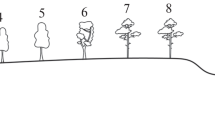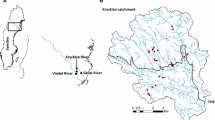Abstract
We studied the vegetation, testate amoebae and abiotic variables (depth of the water table, pH, electrical conductivity, Ca and Mg concentrations of water extracted from mosses) along the bog to extremely rich fen gradient in sub-alpine peatlands of the Upper Engadine (Swiss Alps). Testate amoeba diversity was correlated to that of mosses but not of vascular plants. Diversity peaked in rich fen for testate amoebae and in extremely rich fen for mosses, while for testate amoebae and mosses it was lowest in bog but for vascular plants in extremely rich fen. Multiple factor and redundancy analyses (RDA) revealed a stronger correlation of testate amoebae than of vegetation to water table and hydrochemical variables and relatively strong correlation between testate amoeba and moss community data. In RDA, hydrochemical variables explained a higher proportion of the testate amoeba and moss data than water table depth. Abiotic variables explained a higher percentage of the species data for testate amoebae (30.3% or 19.5% for binary data) than for mosses (13.4%) and vascular plants (10%). These results show that (1) vascular plant, moss and testate amoeba communities respond differently to ecological gradients in peatlands and (2) testate amoebae are more strongly related than vascular plants to the abiotic factors at the mire surface. These differences are related to vertical trophic gradients and associated niche differentiation.



Similar content being viewed by others
References
Gause GF (1934) The struggle for existence. Williams & Wilkins, Baltimore
Wardle DA (2006) The influence of biotic interactions on soil biodiversity. Ecol Lett 9:870–886
Wilkinson DM (1998) Fragments of an entangled bank: do ecologists study most of ecology? Oikos 82:393–394
Wardle DA (2002) Communities and ecosystems: linking the aboveground and belowground components. Princeton University Press, Princeton
Bridgham SD, Pastor J, Janssens JA, Chapin C, Malterer TJ (1996) Multiple limiting gradients in peatlands: a call for a new paradigm. Wetlands 16:45–65
Wheeler BD, Proctor MCF (2000) Ecological gradients, subdivisions and terminology of north-west European mires. J Ecology 88:187–203
Mitchell EAD, Borcard D, Buttler AJ, Grosvernier P, Gilbert D, Gobat JM (2000) Horizontal distribution patterns of testate amoebae (Protozoa) in a Sphagnum magellanicum carpet. Microb Ecol 39:290–300
Clymo RS (1963) Ion exchange in Sphagnum and its relation to bog ecology. Ann Bot 27:309–324
Mitchell E, Charman D, Warner B (2008) Testate amoebae analysis in ecological and paleoecological studies of wetlands: past, present and future. Biodivers Conserv 17:2115–2137
Foissner W (1997) Protozoa as bioindicators in agroecosystems, with emphasis on farming practices, biocides, and biodiversity. Agric Ecosyst Environ 62:93–103
Schröter D, Wolters V, De Ruiter PC (2003) C and N mineralisation in the decomposer food webs of a European forest transect. Oikos 102:294–308
Aoki Y, Hoshino M, Matsubara T (2007) Silica and testate amoebae in a soil under pine–oak forest. Geoderma 142:29–35
Wilkinson DM (2008) Testate amoebae and nutrient cycling: peering into the black box of soil ecology. Trends Ecol Evol 23:596–599
Lavoie C, Zimmermann C, Pellerin S (2001) Peatland restoration in southern Quebec (Canada): a paleoecological perspective. Ecoscience 8:247–258
Laggoun-Défarge F, Mitchell EAD, Gilbert D, Disnar J-R, Comont L, Warner B, Buttler A (2008) Cutover peatland regeneration assessment using organic matter and microbial indicators (bacteria and testate amoebae). J Appl Ecol 45:716–727
Charman DJ (2001) Biostratigraphic and palaeoenvironmental applications of testate amoebae. Quat Sci Rev 20:1753–1764
Opravilova V, Hajek M (2006) The variation of testacean assemblages (Rhizopoda) along the complete base-richness gradient in fens: a case study from the Western Carpathians. Acta Protozoologica 45:191–204
Mazei YA, Tsyganov AN, Bubnova OA (2007) Structure of a community of testate amoebae in a Sphagnum dominated bog in upper sura flow (Middle Volga Territory). Biol Bull 34:382–394
Booth RK, Sullivan ME, Sousa VA (2008) Ecology of testate amoebae in a North Carolina pocosin and their potential use as environmental and paleoenvironmental indicators. Ecoscience 15:277–289
Tolonen K, Warner BG, Vasander H (1992) Ecology of Testaceans (Protozoa: Rhizopoda) in mires in southern Finland: I. Autecology. Arch Protistenkd 142:119–138
Mitchell EAD, Buttler A, Grosvernier P, Rydin H, Albinsson C, Geenup AL, Heijmans MMPD, Hoosbeek MR, Saarinen T (2000) Relationships among testate amoebae (Protozoa), vegetation and water chemistry in five Sphagnum-dominated peatlands in Europe. New Phytol 145:95–106
Heal WO (1961) The distribution of testate amoebae (Rhizopoda: Testacea) in some fens and bogs in northern England. J Linn Soc, Zool 44:369–382
Heal WO (1964) Observations of the seasonal and spatial distribution of testacea (Protozoa: Rhizopoda) in Sphagnum. J Anim Ecol 33:395–412
Lamentowicz M, Mitchell EAD (2005) The ecology of testate amoebae (Protists) in Sphagnum in north-western Poland in relation to peatland ecology. Microb Ecol 50:48–63
Mitchell EAD, Buttler AJ, Warner BG, Gobat JM (1999) Ecology of testate amoebae (Protozoa: Rhizopoda) in Sphagnum peatlands in the Jura mountains, Switzerland and France. Ecoscience 6:565–576
Lauber K, Wagner G (2007) Flora helvetica. Paul Haupt, Bern
Ochyra R, Żarnowiec J, Bednarek-Ochyra H (2003) Census catalogue of Polish mosses. W. Szafer Institute of Botany, Polish Academy of Sciences, Krakow
Hermanowicz W, Dożańska W, Dojlido J, Koziorowski B (1999) Fizyczno-chemiczne badania wody i ścieków. Arkady, Warszawa
Grospietsch T (1958) Wechseltierchen (Rhizopoden). Kosmos Verlag, Stuttgart
Ogden CG, Hedley RH (1980) An Atlas of Freshwater Testate Amoebae. Oxford University Press, London
Clarke KJ (2003) Guide to identification of soil protozoa—testate amoebae. Freshwater Biological Association, Ambleside, U.K
Thompson R, Kamenik C, Schmidt R, Pla S, Rieradevall M, Catalan J (2008) Testing a new multigroup inference approach to reconstructing past environmental conditions. J Limnol 67:155–162
Escofier B, Pagès J (1994) Multiple factor analysis. Comput Stat Data Anal 18:121–140
Rao CR (1995) A review of canonical coordinates and an alternative to correspondence analysis using Hellinger distance. Qüestiió 19:23–63
Borcard D, Legendre P, Drapeau P (1992) Partialling out the spatial component of ecological variation. Ecology 73:1045–1055
Peres-Neto P, Legendre P, Dray S, Borcard D (2006) Variation partitioning of species data matrices: estimation and comparison of fractions. Ecology 87:2614–2625
Mitchell EAD, Buttler A, Grosvernier P, Rydin H, Albinsson C, Greenup AL, Heijmans MMPD, Hoosbeek MR, Saarinen T (2000) Relationships among testate amoebae (Protozoa), vegetation and water chemistry in five Sphagnum-dominated peatlands in Europe. New Phytol 145:95–106
Grunig A (1994) Mires and man: mire conservation in a densely populated country—the Swiss experience. Excursion guide and proceedings of the symposium of the International Mire Conservation Group (IMCG), Switzerland, 1992. Mires and man: mire conservation in a densely populated country—the Swiss experience Excursion guide and proceedings of the symposium of the International Mire Conservation Group (IMCG), Switzerland, 1992
Held T, Wortmann M (1994) Unappreciated by the cross-country skiers - the outstanding mires in the famous Upper Engandine. Birmensdorf: Swiss Federal Institute of Forest, Snow and Landscape Research. In: Grünig, A (ed) Mires and Man Mire conservation in a densely populated country—the Swiss experience Excursion guide and symposium proceedings of the 5th field symposium of the international mire conservation group (IMCG), Switzerland 1992, pp. 218–233
Lamentowicz M, Van der Knaap P, Lamentowicz Ł, Van Leeuwen JFN, Mitchell EAD, Goslar T, Kamenik C (2009) A near-annual palaeohydrological study based on testate amoebae from an Alpine mire: surface wetness and the role of climate during the instrumental period. J Quat Sci (in press)
Glaser PH, Janssens JA, Siegel DI (1990) The response of vegetation to chemical and hydrological gradients in the lost river peatland, Northern Minnesota. J Ecol 78:1021–1048
Hájek M, Horsák M, Hájkova P, Dítě D (2006) Habitat diversity of central European fens in relation to environmental gradients and an effort to standardise fen terminology in ecological studies. Perspect Plant Ecol Evol Syst 8:97–114
Hájkova P, Wolf P, Hajek M (2004) Environmental factors and Carpathian spring fen vegetation: the importance of scale and temporal variation. Ann Bot Fenn 41:249–262
Vitt DH (1990) Growth and production dynamics of boreal mosses over climatic, chemical and topographic gradients. Bot J Linn Soc 104:35–59
Vitt DH, Li YH, Belland RJ (1995) Patterns of bryophyte diversity in peatlands of continental Western Canada. Bryologist 98:218–227
Beilman DW (2001) Plant community and diversity change due to localized permafrost dynamics in bogs of western Canada. Can J Bot 79:983–993
Mazei YA, Bubnova OA (2007) Species composition and structure of testate amoebae community in a Sphagnum bog at the initial stage of its formation. Biol Bull 34:619–628
Bragazza L, Gerdol R (2002) Are nutrient availability and acidity-alkalinity gradients related in Sphagnum-dominated peatlands? J Veg Sci 13:473–482
Vitt DH, Slack NG (1984) Niche diversification of Sphagnum relative to environmental factors in northern Minnesota peatlands. Can J Bot 62:1409–1430
Vitt DH, Chee W-L (1990) The relationships of vegetation to surface water chemistry and peat chemistry in fens of Alberta, Canada. Vegetatio 89:87–106
Bragazza L (1997) Sphagnum niche diversification in two oligotrophic mires in the southern Alps of Italy. Bryologist 100:507–515
Bragazza L, Gerdol R (1999) Hydrology, groundwater chemistry and peat chemistry in relation to habitat conditions in a mire on the South-eastern Alps of Italy. Plant Ecol 144:243–256
Andrus RE (1986) Some aspects of Sphagnum ecology. Can J Bot 64:416–426
Hájek M, Hekera P, Hájková P (2002) Spring fen vegetation and water chemistry in the Western Carpathian flysch zone. Folia Geobot 37:205–224
Navratil J, Navratilova J, Hajek M (2006) Relationships between environmental factors and vegetation in nutrient-enriched fens at fishponds margins. Folia Geobot 41:353–376
Malmer N, Horton DG, Vitt DH (1992) Element concentrations in mosses and surface waters of western Canadian mires relative to precipitation chemistry and hydrology. Ecography 15:114–128
Kohzu A, Matsui K, Yamada T, Sugimoto A, Fujita N (2003) Significance of rooting depth in mire plants: Evidence from natural (15) N abundance. Ecol Res 18:257–266
Hughes PDM, Barber KE (2003) Mire development across the fen-bog transition on the Teifi floodplain at Tregaron Bog, Ceredigion, Wales, and a comparison with 13 other raised bogs. J Ecol 91:253–264
Vitt DH (1994) An overview of factors that influence the development of Canadian peatlands. Mem Entomol Soc Can 169:7–20
van der Linden M, Barke J, Vickery E, Charman DJ, van Geel B (2008) Late Holocene human impact and climate change recorded in a North Swedish peat deposit. Palaeogeogr Palaeoclimatol Palaeoecol 258:1–27
Kuhry P, Nicholson BJ, Gignac LD, Vitt DH, Bayley SE (1993) Development of Sphagnum dominated peatlands in boreal continental Canada. Can J Bot 71:10–22
Daniels RE, Eddy A (1985) Handbook of European Sphagna. HMSO, London
Vitt DH, van Wirdum G, Halsey L, Zoltai S (1993) The effects of water chemistry on the growth of Scorpidium scorpioides in Canada and the Netherlands. Bryologist 96:106–111
Bellamy JD, Rieley J (1967) Some ecological statistics of a “miniature bog”. Oikos 18:33–40
Acknowledgements
We thank Ryszard Ochyra and Iwona Melosik for the identification of the mosses, Ralf Meisterfeld for help in the identification of some difficult testate amoeba taxa and Bertrand Fournier, Aurélie Thébault, François Gillet and Daniel Borcard for advice on numerical analyses. The study is part of the European Union project Millennium (SUSTDEV-2004-3.1.4.1). This research was further supported by the National Centre of Competence in Research (NCCR) on Climate, (Bern, Switzerland). Funding to EM by Swiss NSF project no. 205321-109709/1 and CCES projects RECORD and BigLink is kindly acknowledged. Further funding to ML by Foundation for Polish Science (FNP; Outgoing Fellowship KOLUMB) is acknowledged.
Author information
Authors and Affiliations
Corresponding authors
Electronic supplementary material
Below is the link to the electronic supplementary material.
ESM 1
Supplementary online materials. (DOC 648 kb)
Rights and permissions
About this article
Cite this article
Lamentowicz, M., Lamentowicz, Ł., van der Knaap, W.O. et al. Contrasting Species—Environment Relationships in Communities of Testate Amoebae, Bryophytes and Vascular Plants Along the Fen–Bog Gradient. Microb Ecol 59, 499–510 (2010). https://doi.org/10.1007/s00248-009-9617-6
Received:
Accepted:
Published:
Issue Date:
DOI: https://doi.org/10.1007/s00248-009-9617-6




